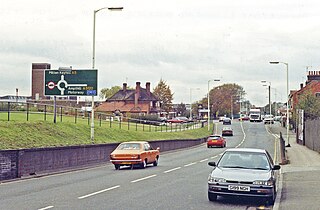Related Research Articles

Luton is a town and unitary authority with borough status in Bedfordshire, England, with a population at the 2021 census of 225,262.

Bedfordshire is a ceremonial county in the East of England. It is bordered by Northamptonshire to the north, Cambridgeshire to the north-east, Hertfordshire to the south and the south-east, and Buckinghamshire to the west. The largest settlement is Luton (225,262), and Bedford is the county town.

The Chiltern Hills are a chalk escarpment in southern England, northwest of London, covering 660 square miles (1,700 km2) across Oxfordshire, Buckinghamshire, Hertfordshire, and Bedfordshire, stretching 45 miles (72 km) from Goring-on-Thames in the southwest to Hitchin in the northeast. The hills are 12 miles (19 km) at their widest.

Leighton Buzzard is a market town in Bedfordshire, England, in the southwest of the county and close to the Buckinghamshire border. It lies between Aylesbury, Tring, Luton/Dunstable and Milton Keynes, near the Chiltern Hills.

Toddington is a large village and civil parish in the county of Bedfordshire, England. It is situated 5 miles north-north-west of Luton, 4 miles (6 km) north of Dunstable, 6 miles (10 km) south-west of Woburn, and 35 miles north-north-west of London on the B5120 and B579. It is 0.5 miles from Junction 12 of the M1 motorway and lends its name to the nearby motorway service station. The hamlet of Fancott also forms part of the Toddington civil parish.

Mid Bedfordshire is a constituency represented in the House of Commons of the UK Parliament by Alistair Strathern of the Labour Party since a 2023 by-election.

Barton-le-Clay is a large village and a civil parish in the Central Bedfordshire district of Bedfordshire, England, bordering Hertfordshire. The village has existed since at least 1066 and is mentioned in the Domesday Book.

The University of Bedfordshire is a public research university with campuses in Bedfordshire and Buckinghamshire, England. The University has roots in further and higher education from 1882: it gained university status in 1993 as the University of Luton. The University changed its name to the University of Bedfordshire in 2006, following the merger of the University of Luton with the Bedford campus of De Montfort University.

Dart Aircraft Limited was a British aircraft manufacturer during the 1930s. Its facilities were located at 29 High Street North, Dunstable, Bedfordshire.

The Luton L.A.4 Minor was a 1930s British single-seat high-wing ultra-light aircraft. The prototype was built by the Luton Aircraft Limited, and design plans were later adapted and copies sold for homebuilding.

The Luton L.A.5 Major was a 1930s British two-seat high-wing cabin monoplane. Following World War II, plans were made available to suit construction as a homebuilt aircraft.

The Luton Buzzard was a 1930s British single-seat, open cockpit ultralight aircraft built by Luton Aircraft Limited.

Dunstable is a market town and civil parish in Bedfordshire, England, east of the Chiltern Hills, 30 miles north of London. There are several steep chalk escarpments, most noticeable when approaching Dunstable from the north. Dunstable is the fourth largest town in Bedfordshire and along with Houghton Regis forms the westernmost part of the Luton/Dunstable urban area.
Cecil Hugh (Chookie) Latimer-Needham was a British aircraft designer, inventor and aviation author. He is best remembered for the series of aircraft he designed for the Luton Aircraft company and his invention of the Hovercraft skirt for which he was granted a patent. His book, Aircraft Design proved to be an invaluable reference work for Bill Goldfinch and Jack Best during their construction of the Colditz glider. The Germans were rather careless in providing a copy of the book in the Colditz prison library.

Dunstable North was a railway station on the London and North Western Railway's branch line from Leighton Buzzard which served Dunstable in Bedfordshire from 1848 to 1967. Originally the terminus of the London and North Western Railway's branch line from Leighton Buzzard, Dunstable became the point where the line met with the Great Northern's branch line from Luton in 1858. The station became the hub of a number of sidings connecting a variety of concerns to the line, including Waterlows, Bedfordshire County Council, Associated Portland Cement, Dunstable gasworks and a coal yard operated by the Great Northern. Against a background of falling passenger numbers and declining freight returns, the station closed to passengers in 1965 and to goods in 1967. Connections were retained with the cement works and coal yard, which became an oil depot, until 1988 and the line eventually closed in 1991. The site of the station is now occupied by offices of Central Bedfordshire Council. A section of the former line to the west of the site has become part of route 6 of the National Cycle Network.
This is an outline of Sport in Bedfordshire, a county in England.
Barton-Le-Clay Airfield was first established in 1935 to the west of the village, on farmland owned by the nearby Brook End Green Farm. Its first residents were the newly formed Luton Aircraft Limited and The Dunstable Sailplane Company, both companies co-owned by W.L. Manuel and C.H. Latimer-Needham.
The Dunstable Sailplane Company was established in 1934 by W.L. Manuel and C.H. Latimer-Needham to design, manufacture and repair gliders from its workshop at Barton-Le-Clay Airfield in Bedfordshire.
The Latimer-Needham Albatross was the first British-designed and constructed sailplane, flying in 1930. Only one example of this single-seat, wooden aircraft was built.
Phoenix Industries, Inc. was an American aircraft manufacturer based in Southampton, New Jersey. The company specialized in the design and manufacture of powered parachutes and paramotors in the form of ready-to-fly aircraft in the US FAR 103 Ultralight Vehicles category.
References
- Jackson, A.J. (1974). British Civil Aircraft since 1919 Volume 2. London: Putnam. ISBN 0-370-10010-7.